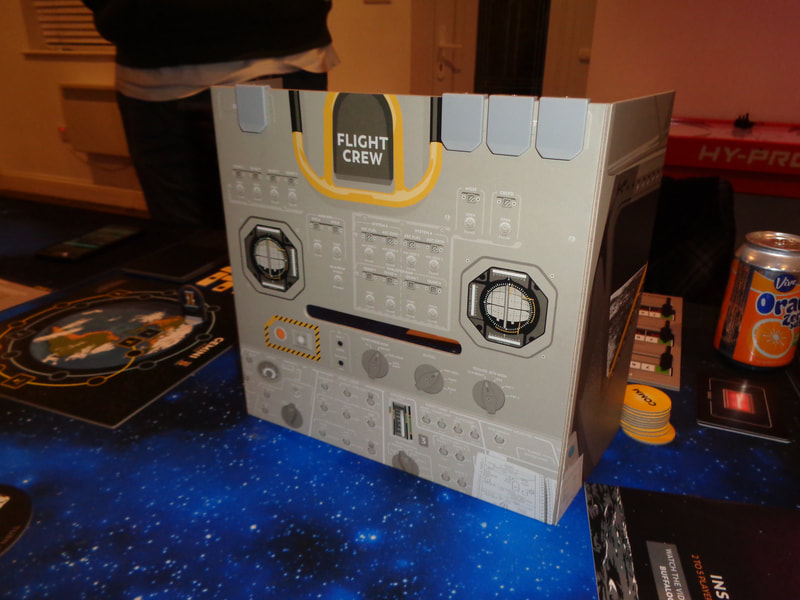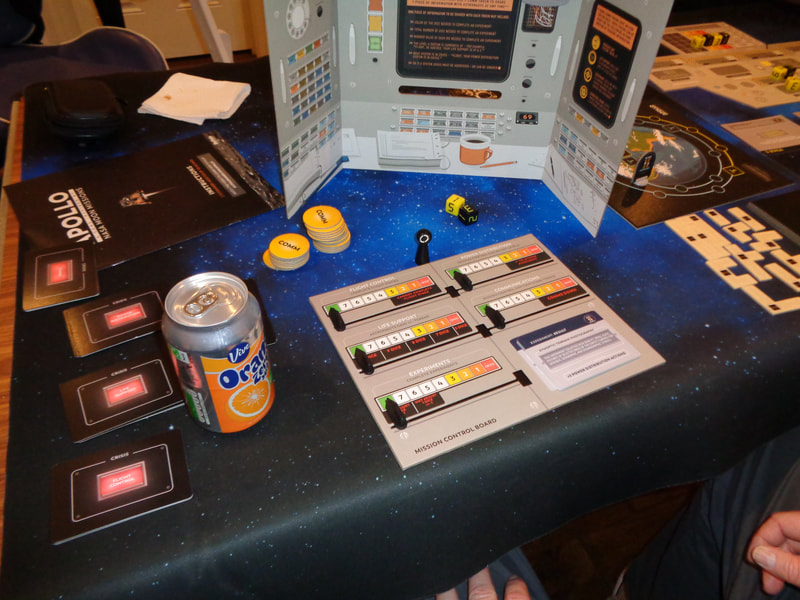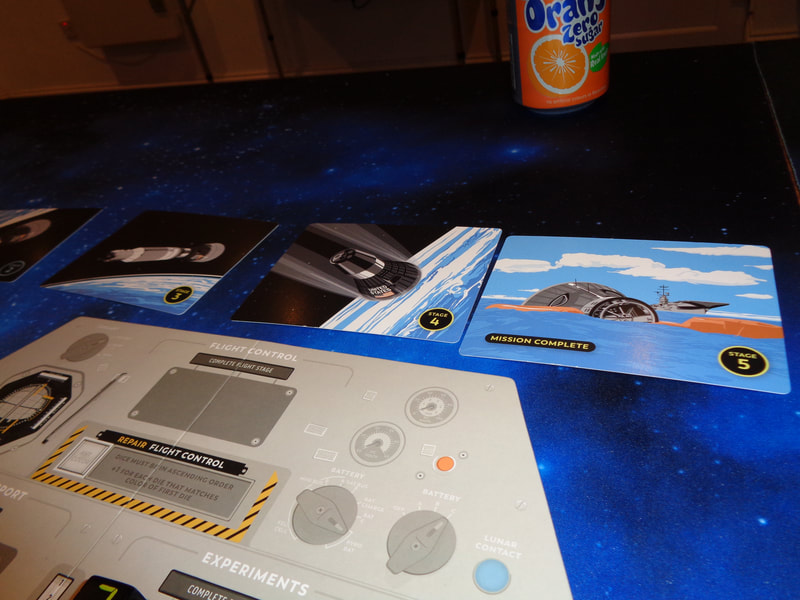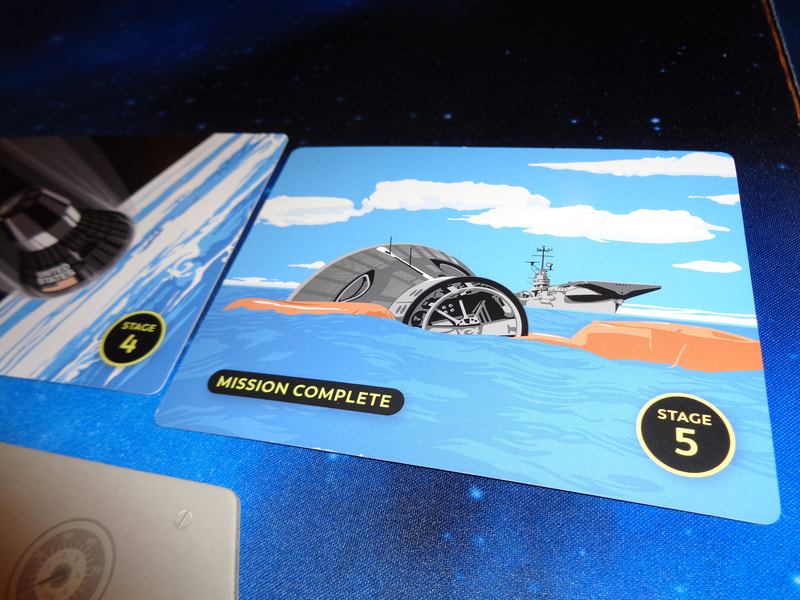|
26th July 2022 It's Tuesday! That means it's time to meet up with the Woking Board Gaming Club at the The Sovereigns. Time to steal the idol... and escape, Indiana Jones has nothing on this real-time, cooperative dice game, well at least until those crappy rolls inevitably turn up! What's in a game?
Escape: The Curse of the Temple has good quality components. The tiles all feel suitably thick and sturdy. The acrylic gem tokens are kind you see in a lot of games which use them to depict gems, they are a sparkly, pleasing shade of green though. The bespoke dice and meeples are wooden which is always a nice touch. There's not much art to speak of, the tiles show flagstones and that's about it. It's clear artwork that does not get in the way. About half a dozen icons are used throughout the game, luckily they most relate to the dice and there's never a need to refer to the rules - which is a good thing since this is a real time game with a countdown. How's it play? Setup
On to play In Escape: The Curse of the Temple players are collectively attempting to explore a lost temple to find the exit and escape before becoming trapped. It's not so simple though; not only must they find the exit, they'll also need to activate the gem tiles and spaces to make their escape possible. The game is played over 3 rounds and does not use a typical turn structure. Instead, turns are actually synchronous, in other words, players perform all their actions at the same time and in real time! This involves all players rolling their dice and resolving their actions simultaneously. How is this all done? Read on.
Endgame When the 3rd and final round begins, all players must get to the exit tile and successfully perform the escape action.
The soundtrack has a total countdown across all 3 rounds of 10 minutes. If one or more players are still in the temple when the countdown has finished, then they collectively lose the game. If all the players have escaped before the time runs out, then the players collectively win! Overall
I'm going to start by saying that I'm a bit ambivalent towards real time games. I've played some good ones and can see how they have their place in gaming but for me but broadly speaking, it's not why I like and play board games. I like to think out my decisions and choices at least a little bit. Add to the mix a push-your-luck dice mechanic and you've a game of a lot of quick frantic rolling. You really don't want to roll those dice off the table! Having said all of this, I think Escape: The Curse of the Temple is a solid game and there's a lot to like about it. Firstly, rules and theme mesh together well. Chucking dice as quickly as you can to escape feels good. The synchronous dice rolling is a clever little system. Generally real time games are always trying to impress upon players that they're up against the clock, this can be a little jarring in a game where players are having to wait for another player's time to run our and get their turn. By having synchronous actions, it heightens the sense of urgency as everyone is in it together. Being able to provide assistance another player on the same tile is equally clever. It's an elegant mechanic that also feels organic and makes sense. This means it would seem like a good idea to have players explore the temple as a group, it would make shifting gems and unlocking dice easier... But there's a couple of rules that throws a spanner into that strategy. Firstly; exploring as group can slow down that exploration. Players can't escape if they don't shift enough gems or find draw exit tunnel from the stack. Secondly; players will want to avoid creating single long corridors, they will need to return to the starting tile twice and the further away they are from it, the further it is to get back. This will force players to split up or go in pairs or stick close by if they have the option, at least for the first 2 rounds. This can change contextually when certain tile are revealed or have to be put in play in a certain way or a player get too many locked dice and so on. Players will have to think quickly and decisively as well as adapt to emergent events. Escape: The Curse of the Temple obviously has a quick playtime - 10 minutes! That feels a little strange because the setup and explanation time almost feels longer than a single game. It's reasonably easy to learn, I can't imagine novice gamers struggling to learn the concepts here. It also not a game to be taken too seriously and leans heavily on luck which is not unusual for cooperative games. Although, even accepting this, a bad run of rolls can sour the experience. But treat Escape: The Curse of the Temple as a cooperative, silly, fun, filler of a game and it will be a enjoyable time. So long as your luck is better than mine... much better!
0 Comments
28th January 2022 It's Friday evening and we're round Simon's for a night of gaming. The game of the night was Apollo. Houston.... we've had a game here. One small step for gaming and errr, umm... one cooperative game for gamers? Anyway, enough of the bad jokes. What's in a game? Apollo is an symmetrical cooperative game where 1 player take on the role of mission control and the other players take on the role of astronauts on the titular mission.
The boards, tokens and player screen are all constructed of suitability thick card. While the dice are not wooden, they use a old school LCD numeric font for the numbers which is pretty cool, as are the pouches to store the mission cards. The astronaut board and particularly the player screen feature very well themed artwork that calls back to sixties computer tech. The art on the astronaut board displays various dials and buttons is perhaps a little sparse but is also clean and doesn't interfere with the game element. Most of the player screen is decorated with evocative artwork of of what I imagine is module controls, the inside has some game information but the rest is an illustration of what mission control might look like. Dig the cup of coffee! The art that depicts the Earth and the Moon is perfectly fine, they look like what they're meant to. Finally, the flight stage cards are double-sided and as each one is completed, it's flipped over to show an illustration of that actual stage, which is a nice touch. The game features little in the way of dedicated iconography, all the information is presented clear terms and is easy to comprehend. How's it play? Setup Since Apollo is a asymmetrical game, it has a asymmetrical setup.
On to play Apollo is played over a number of rounds, each round has its setup and then is played over a number of turns. To make matters worse, Apollo is played in real time and each round only lasts 4 minutes.
What are these actions and how do they work?
Endgame During play, if the module passes a flight stage space on the board without completing its requisite task or the flight control rating is lower then 4, then the mission immediately fails. If the module reaches splashdown without completing the required number of experiments, then the mission fails. However, if all the flight stages and experiments are completed, then mission is a success and the players win the game. Overall
The rules for Apollo sound quite clunky in writing but in actual play, they felt straightforward and once players begin performing actions, it becomes quite understandable. I wouldn't call it a crossover game but I imagine that it would be easy to pick up. Apollo is quite unusual, being an asymmetrical cooperative game and I think it fits its theme quite well too. Having that slight disconnect between mission control and the astronauts somehow lends the game a greater sense of teamwork. Astronauts having to rely on mission control to get information and mission control having to rely on the astronauts to get comms tokens and to be able to make changes to systems means players have to work together. It's definitely a bit different to the typical cooperative game where players are cooperating but generally sort of off doing their own thing. Another noticeable and welcome difference is how there's no characters running round a global board trying to stop the spread of something here. During the game, players will be, broadly speaking, faced with 3 types of obstacle; successfully completing flight stages, successfully completing experiments and firefighting damage that occurs during the flight. There's a real need to strike a balance between these 3 priorities and players will also have to approach this as efficiently as possible, the flight module moves along the board after every turn and is in essence another countdown timer. It means planning for the known variables of the flight stages, somewhat knowable experiments and also reacting and adapting to unpredictable damage inflicted on the command module and there will be damage! There are 15 damage spaces on the flight damage board and only 10 dice to cover them, that means at least 5 damage to the systems every round. Being a cooperative game, Apollo uses the luck or specifically the bad luck that arises from rolling those dice to challenge players. The game also features a time limit in the form of a 4 minute timer: On paper this might not seem like much time but in play it's perhaps a little overgenerous. 4 minutes to assign 10 dice works out to be 240 seconds for 10 dice or 24 seconds per die, which we did not find much of an issue. We played the Gemini mission board a couple of times and it didn't present too much challenge for us, there were a definite couple hiccups and dicey (sic) moments but otherwise it was pretty much plain sailing or more accurately, plain err.... orbiting? Mission control never had to reach for the puzzle boards. However, we are a fairly experienced band of players and maybe for once, the luck went our way this time. We didn't get round to playing the Apollo mission board which is probably where the meat of the game lies and certainly looks more challenging, so I'm reserving judgement on the game's difficulty. I'm not certain about the game's replay-ability either, it wasn't boring but at the same time felt a little samey, players are ultimately just assigning dice to tasks, some of which may become quite familiar over multiple plays. Easy to learn with a reasonable play time and providing some interesting decisions to make, I'd say that Apollo is a good game to play every once in awhile and if cooperative games are your cup of tea, then it's definitely worth checking out this fresh take on cooperative gameplay. 26th November 2019 Tuesday gaming night at 'The Sovereigns' is here. The first game of the evening was 'Nine Tile Panic'. Nine Tile Panic is a game that comes in a little box that delivers a lot of stress! This is a game all about building a city but not just building a city. It's a game about building a city in a strict time limit! Thinking about it, maybe we should get real city planners to play this game? You won't find any unoccupied roadworks in Nine Tile panic let me tell you. What's in a game? 'Nine Tile Panic' has few components:
How's it play? Before playing, give each player a set of tiles. Nine Tile Panic is played over a series of rounds. Each round is scored before play proceeds to the following round. A round goes like this:
Play continues until the score limit has been reached. For a 5 player game this is 25 points. Final scores are tallied, highest score wins. Overall
Nine Tile Panic is a small, quick to learn and quick to play game. A game can be 20 more than 20 minutes. The game is supposed to be fun, but it should be called 'Nine Tile Stress!'. Why? Because there will always be that one player who's going to finish their city too quickly just to watch the other players suffer! That's why. Always! You'll be swearing under your breath as any strategy you've concocted will fly out of the window and you'll just be trying to make any city you can! And seriously, that's what makes Nine Tile Panic a good game and fun too. If you have friends who like real time games, you should play this with them. And if you have friends who hate real time games you should definitely play this with them! 12th July 2019
Friday gaming in lieu of WFRP continues with the 3rd game - 'Pit Crew' We've all seen it, when a racing car pulls into the pits and the pit crew goes mental changing the tyres and refuelling the car. Pit Crew is a 'team-based' card game that attempts to emulate this frenzied burst of activity by being a 'real-time' game. How does this work? Well let's get to it. What's in a game? Pit Crew is a team based game and players will be in up to 3 teams of 1-3 people each. Thus the game supports 2-9 players. Components include:
How's it play? Firstly, all players are split up into teams of up to 3 each. Each team is given a car sheet and each team is dealt a hand of numbered cards (Split between the team players.). The objective of Pit Crew is to change the tyres and refuel your car as a team and then race it around the track on the game board. All of this is done in real time! Changing tyres To change tyres, the team must play 4 cards next to each tyre.
In order to refuel the car, multiple cards must be played on the refuelling number on the car sheet. The combined values of all of these cards must equal the value on the car sheet. Thus if the car sheet has a value of 23 for refuelling, then playing a 6, 4, 10 & 3 would equal 23. Exiting the pits Once all 4 tyres and refuelling has been completed, the car can exit the pits and enter the race. However there's a little twist here. The better the pit change, the quicker the car comes out of the pits (The more spaces it moves.). How is this calculated? This is where the colours of the cards come in play. If the cards used to change tyres are of a certain colour combination, then the car gets a bonus when leaving the pits. The same is the case for refuelling. Conversely; if the cards played on the tyres or fuel are the wrong numbers, then the car will suffer a penalty when leaving the pits. If the penalty is bad enough, the car might crash out of the game! Racing Once a car exits the pit lane and begins racing, the team rolls a die to move. This rolling is real time and the quicker they roll the dice, the more they can move. However once all cars have exited the pits, real time rolling ceases. From now on all rolling is done in turn order until the race is completed. A game consists of several races. After a race is completed, each team is given a 'bonus' card. Bonus cards confer random special abilities that can help a team or be used to hinder an opposing team. Endgame Once all the races have been run, the team that has won the most races wins. Overall Pit Crew is a small, quick and easy game to learn. Which is good, because stopping to query the rules in the middle of a real time game could prove tricky. This is the first real time tabletop game I've played and I've always been a bit suspicious of the concept. But Pit Crew was fun. I think this partially because each team plays separately and does not interfere with each other during the real time phase of the race. You have your teammates to consider! Pit Crew is a cooperative game about completing tasks quickly, but accurately in a team. The Pit Crew theme fits it very well. I think that Pit Crew is a game worth trying. |
AuthorI play, I paint. Archives
March 2024
Categories
All
|



























 RSS Feed
RSS Feed
